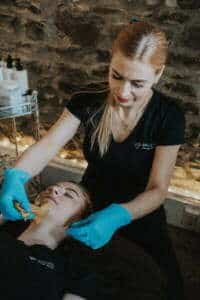What is Rosacea?


Four Sub-type:
- Erythematotelangiectatic: Redness, flushing, visible blood vessels.
- Papulopustular: Redness, swelling, and acne-like breakouts.
- Phymatous: Skin thickens and has a bumpy texture.
- Ocular: Eyes red and irritated, eyelids can be swollen, and the person may have what looks like a sty.
Famous People with Rosacea
If you are living with rosacea, you are in good company. Some famous people have this condition too:- Bill Clinton
- Diana, Princess of Wales
- W.C. Fields (a film star in the 1920s and 1930s)
Who Gets Rosacea?
Rosacea is common. According to the U.S. government, more than 14 million people are living with this skin condition. Most people who get rosacea are:- Between 30 and 50 years of age
- Fair-skinned and often have blonde hair and blue eyes
- From Celtic or Scandinavian ancestry
- Likely to have someone in their family tree with rosacea or severe acne
- Likely to have had lots of acne — or acne cysts and/or nodules
Causes of Rosacea?

- It runs in families. Many people who get rosacea have family members who have it too. People may inherit genes for this specific skin condition.
- The immune system may play a role. Scientists found that most people with acne-like rosacea react to a bacterium (singular for bacteria) called bacillus oleronius. This reaction causes their immune system to overreact. Scientists still do not know whether this can cause rosacea.
- A bug that causes infections in the intestines may play a role. This bug, H pylori, is common in people who have rosacea. Scientists cannot prove that H pylori can cause redness. Many people who do not have this skin condition have an H pylori infection.
- A mite that lives on everyone’s skin, Demodex, may play a role. This mite likes to live on the nose and cheeks, where the redness often appears. Many studies found that people with rosacea have large numbers of this mite on their skin. But there are people with this mite on their skin who do not experience any redness.
- A protein that normally protects the skin from infection, cathelicidin, may cause redness and swelling. How the body processes this protein may determine whether a person gets rosacea.


